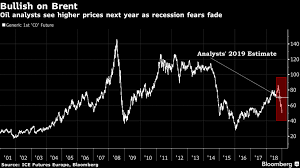Fears of recession have faded

INVESTORS STARTED the year brooding about the risk of an American recession. Torsten Slok of Deutsche Bank, Germany’s biggest lender, says clients around the globe were worried. Financial indicators were flashing red, the stockmarket was weak and yields on low-grade corporate debt had jumped. The Federal Reserve’s decision to raise interest rates in December had been unsurprising, but unwelcome.
At the end of the year a model from economists at JPMorgan Chase had put the chances of a recession within 12 months, based on the S&P 500 index and corporate-credit spreads, at 65%. But the mood has now improved. By April 29th JPMorgan’s model was putting the chances of a recession at just 15%.
“It’s eye-popping how quickly the narrative has changed,” says Mr Slok. One reason for the improvement in sentiment is the Fed’s evolving monetary-policy stance. In January it turned more doveish, abandoning its plans to raise rates in 2019. “We don’t see any evidence at all of overheating,” said Jerome Powell, the chairman of the Federal Reserve, on May 1st after announcing that the Fed would maintain its patient stance. He also repeated his view that the data do not warrant higher rates.
Investors have been delighted by the Fed’s pause. But the timing and extent of their change of mood suggests that is not the full story. One possibility is that their previous gloom may have been overblown. “The market collapse in December was driven by the calendar,” says Catherine Mann of Citigroup, a bank, as investors repositioned for tax purposes. The “inverted yield curve”—that is, yields on long-term bonds below those on short-term ones, historically a sign that a recession is on the way—has been ringing alarm bells recently. But Ms Mann doubts its continued predictive power after a long period in which central-bank intervention depressed interest rates.
The real economy had also shown some signs of an approaching downturn, however. Business confidence had soured and the housing market, so often a leading indicator of economic trouble, had sagged. At the start of 2019 came more bad news, as a lengthy partial federal-government shutdown depressed both output and consumer sentiment. The economy had been expected to cool a little anyway, as the impetus from the Trump administration’s fiscal stimulus faded. The fear that a soft landing might turn into a hard one did not seem far-fetched.
Jesse Edgerton, an economist at JPMorgan Chase, says there are still reasons to be cautious, notably weak business confidence. But more recent data have looked rosier. Sentiment among consumers has rebounded. Jobs growth in March recovered from a hiccup in February (April’s figures are due on May 3rd, after The Economist went to press). And although GDPgrowth of 3.2% in the first quarter hid some softening components, recent trends suggest that they will bounce back.
Investors in the stockmarket seem to have forgotten the whole scare, and to believe that the economy will grow fast enough to produce profits but not so fast that the Fed will have to intervene. Investors in government debt seem warier. They are still betting that the Fed will cut interest rates at least once by the end of the year.
For now, the Fed has decided to sit tight. Since the stockmarket wobbles late last year, a different difficulty has become much more obvious. Inflation, which the Fed had expected to hover around 2%, fell to just 1.6% in March, based on a measure that excludes (volatile) food and energy prices. On May 1st Mr Powell said that he saw good reasons to expect it to be “transitory”. But that is not the behaviour expected of an economy that is humming along nicely. It is a better problem for the Fed to face than an imminent recession—but it is a problem, all the same.


